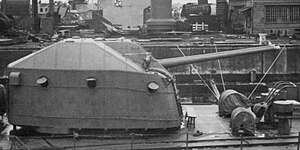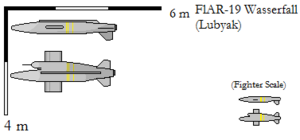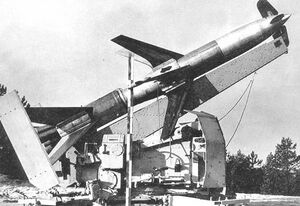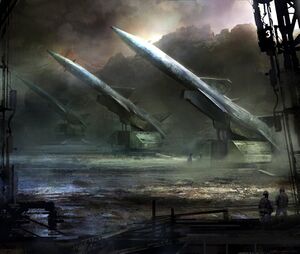Imperial & Federal Aerospace Defence Weapons
The Imperial and Federal Union uses a wide variety of weapons to defend forces and installation on the surface from aerial and voidborne attack. Aerospace Defence Weapons contain both like flak guns for use against low altitude craft to massive anti-orbital cannons meant to engage voidborne targets in low orbit of a world.
Guns
3.7 cm FlaK-40
Description
The 3.7 cm Flak 40 is a light flak cannon utilised by the Imperial & Federal Common Army and a wide variety of member state Landwehr and militia forces across the Imperial & Federal Union. The 3.7 cm FlaK 40 is fielded and produced in a large number of models, but the most common and recognisable is the 3.7 FlaK 40 Quad Fliegerhammer variant, which mount four FlaK 40s on the same platform. This variant can put out nearly 2,000 bolts a minute, if properly supplied with ammunition. The FlaK 40 is generally mounted to a cruciform base, with a jack on each leg of the base to balance the gun. For mobility, the FlaK 40 can be towed by a gravitic engine for relocation, although the weapon's base does include a smaller engine so that it can be re-located over short distances by the guns crew. The FlaK gun does not mount its own reactor, and so relies on capacitors to power its engine. These capacitors also provides the power for the operation of the cannon. When entrenched, FlaK-40s will generally be attached to the local power grid rather than relying on its internal capacitor.
A FlaK 40 will generally require a crew of five men each, a gun commander, a gunner, a targeteer, and two engineers to supervise the bolt and energy feeds. This crew will be supplemented by a larger team from the flak battery's--or battalion's--support section, who will ensure a steady supply of both bolts and replacement capacitors as needed. The targeteer is responsible for supervising the fire computer, and directing the fire of the weapon against identified targets. When fully deployed, the FlaK 40 will often be networked with other weapons via a central fire control system to allow for massed coordinated fire.
Use
The FlaK-40 is primarily used as a point and short range aerospace defence weapon. Unlike its heavier counterparts, the FlaK-40 can not reach the interface between void and atmosphere, and is so limited. However, its high rate of fire and light weight allows it to track and engage even extremely fast moving strike craft and ordnance. While FlaK 80s and Reinhold guns are capable of reaching higher, or causing more damage to heavily protected targets, their relatively low rates of fire make them less effective against close in targets. As such, the FlaK 40 is often used to protect these heavier weapons against close in attack, so that they may continue to operate unimpeded against larger targets. In tactical situations,the FlaK 40 is also very mobile, and can be rapidly brought forward to protect infantry and cavalry in the field, while heavier weapons may not be able to react appropriately to a changing tactical situation.
Mk X 22 kg DP Reinhold Gun
Description
Use
8.8 cm FlaK-80
Description
The 8.8 cm FlaK 80 is a heavy flak cannon utilised by the Imperial & Federal Common Army, as well as the Imperial & Federal Navy and member state militia's for heavy aerospace defence. The 8.8 cm FlaK 80 is produced in a variety of forms, but the two most commonly seen varieties are the Hübsch Marie twin variant and the Dicker Marie single mount variant. Both of these variants are generally capable of firing twenty bolts per round per minute, when properly supplied with the necessary energy and ammunition. Like with other FlaK cannons, the FlaK 80 is mounted on a cruciform base, with jacks to balance the gun, and an integral gravitic engine to allow for limited relocation of the weapon on the field. However, the FlaK 80--particularly the Hübsch Marie version is a very heavy weapon, and without access to an external gravitic engine, the weapon is clumsy and slow to maneuver, even over short distances. The FlaK 80 does mount a small generator, which can supplement--but not replace--its capacitors for the process of energising and firing the weapon.
A FlaK 80 is crewed by ten beings, a gun commander, gun chief, two gunners, two loaders, two targeteers, and two engineers. The crew will be supplemented by extra forces from the battalion support section, who provide logistical support to the gun. The loaders and gunners are responsible for fighting the gun itself, actually aiming and loading the weapon, supervised by the gun commander. The gun chief, targeteers, and engineers are responsible for supervising both the logistical and maintenance of the gun, as well as co-coordinating with battery and battalion level fire control for maximum effectiveness of the unit as a whole.
Use
The FlaK 80 is a mainstay of aerospace defence for both the Common Army and the Navy. In Common Army service, the FlaK 80 is used as a primary line of defence against strike craft and other vessels entering a world's atmosphere. The FlaK 80 can reach as high as--and even slightly beyond--the interfect between void and atmosphere, and thus can begin firing on targets as soon as they begin the re-entry process. Its heavy shells enable it to cause severe damage to even well shielded and armoured vessels. Furthermore, the armour piercing and petard rounds issued to the FlaK 80 for anti-ship work have proven very effective against surface targets, including various types of panzer, infantry reflectors, and other hard targets.
The FlaK 80 is also the primary strike craft defence weapon of the Imperial & Federal Navy, with most vessels carrying large numbers of them in Heilges Marie twin mounts. These mounts are usually gathered in batteries, or concentrated in defencce blisters, along the whole of the ship. In the void, the FlaK 80 lacks the range to engage most ships, but is uniquely suited for engaging strike craft.
Mk IX 40 kg DP Reinhold Gun
Description
The Mk IX 40 kg Dual Purpose Reinhold Gun is one of the most popular weapons in the Imperial and Federal Union. It is used extensively by the Navy and the Common Army in a wide variety of roles, ranging from strike craft defence, light anti-ship, and even functioning as heavy field or light siege artillery when necessary. The Emil, as the weapon is commonly called, is a common sight on both ground and voidbound fortresses. The Emil is most commonly seen in a twin mount, called the Dicker Emil, which places two guns in an enclosed turret. However, single mounts are still commonly see, both as casemate guns and as field guns. The Dicker Emil mount is usually not mobile, without the aid of an engineering entrenchment crew. It is usually entrenched as an immobile turret as part of the defences of a fortress, city, or other military installation. The turret is armoured and enclosed, and includes its own reactor to provide power to its cannons and turret mechanisms. The Dicker Emil mount generally is connected to a protected magazine, which contains its stockpile of lasbolts, making the Dicker Emil almost entirely self contained. As the Emil is an exceptionally heavy, only the enclosed Dicker Emil turret is capable of being used against strike craft. The more mobile versions, mounted on a more standard wheeled chassis like other Common Army artillery, are almost purely used against surface targets.
The Dicker Emil, espescially in its turreted form usually contains a crew of fifteen beings, including a mount chief, a gun chief, four gunners, four loaders, two targeteers, and three engineers. This crew is responsible not only for fighting the gun when needed, but also for supervising the mount's power generation systems. As the Dicker Emil is usually a major weapon for a fortress, arranged as part of a larger battery, the gun chief is responsible for fighting the gun itself, while the mount chief holds responsibility for ensuring the gun is operating properly in conjunction with the rest of the battery.
Use
The Mk IX 40kg Reinhold Gun is primarily used as a direct fire weapon as part of larger fortification systems of a world. In general, the Mk IX will be used as the centre piece of a bastion, where it will be supplemented by other light weapons. The Mk IX will target major positions or forward deployed troops, and can also be used against strike craft within the atmosphere. Although shorter ranged than weapons like the FlaK-80, the Mk IX is often more effective against large formations of strike craft. In addition, the Mk IX can be used in the light antiship role against voidbound vessels which have entered the atmosphere to support ground troops. In which case, the powerful lasbolts of the Mk IX provide a much needed middle ground between heavy anti ship weapons meant for fire against targets in orbit, and FlaK weapons intended for use against much smaller strike craft.
Similar uses are found for the Mk IX in naval service, where it is commonly seen as part of the secondary battery of cruisers and capital ships, or the main battery of destroyers, frigates, and light cruisers.
Mk V Reiger Heavy Lance
Description
The Mk V Reiger Heavy Lance is one of the most powerful conventional weapons in widespread use by the Imperial and Federal Union. Designed as an orbital defence cannon from the outset, the Reiger Mk V, more popularly known as Langer Franz, fills the heavy anti-ship role for aerospace defence. Too large to be mounted on a mobile platform, the Reiger Mk V is limited to service as part of a world's fortifications, mounted on both naval and grounded fortresses. The Reiger Mk V is much too large to be moved, except in a broken down fashion, and can only be fired from a fixed position, after significant entrenchment work. The Reiger Mk V mount will generally be integral to a larger fortress, drawing ammunition from a well protected central magazine, and powered by the fortress's main reactor or generator system. Moreover, the mount is well armoured and protected, with the turret mechanisms and fire control system buried deep underground beneath multiple layers of armour.
As such a large weapon, the Mk V Reiger requires an exceptionally large crew. In general, the Reiger-40 will require a crew of more than two hundred beings. As Reiger Mk V batteries are usually centrpieces of a worldwide defence network, the crew of the weapon bears responsibility for co-ordinating their actions with the rest of the defence network as a whole. An individual Reiger Mk V will be capable of engaging vessels in a fairly wide cone of engagement, and when multiple batteries are deployed, can successfully engage and drive off even large capital warships. However, the expense of the weapon, and its necessary support systems, often means that only the most important areas of a world are protected by Reiger Mk V equipped fortresses.
Use
The Reiger Mk V's use is an integral part of a world's defense structure, and entire fortresses are built up around batteries of these weapons to protect them against retaliatory attack. The general goal of the Reiger Mk V is to either destroy vessels in orbit, or drive them off so they are unable to either conduct direct bombardment operations of vital targets, or land ground troops too close to vital installations, or centres of political and economic power on the world's service. Since interface defence batteries can not be located everywhere, they are generally concentrated around the most important centres of the world as part of a wider global fortification scheme. In general, the goal of the interface artillery is not to drive off an invasion on their own, but to force the invaders to land their forces in unfavourable terrain, where they will be forced to slowly advance against and reduce multiple other fortresses and field forces in order to capture the key areas. This will delay the invader, until relief forces can arrive.
Missiles
Fliegershreck IV Man Portable Defence Missile
Description
The Fliegershreck IV is a light weight, man portable aerospace defence missile. Although only capable of reaching targets in the low atmosphere, its simple 'fire and forget' missiles are effective against most close support strike craft.
Use
The Fliegershreck IV is primarily used by platoon level heavy weapons teams, or distributed to rifle squads to counter the threat of low flying hostile aerospace craft.
FlaR-19 Wasserfall Point Defence Missile
Main article: FlAR-19 'Wasserfall'
Description
The FlaR-19 Wasserfall, commonly used by the Imperial & Federal Aerospace Troops can also be fired from surface launchers. It is a medium weight missile, incapable of reaching orbit from the surface, and is deployed in both defence of field units and as part of integrated orbital defence networks. The FlaR-19s primary target is formations of strike craft or lighter vessels descending from orbit.
Use
The FlaR-19 is primarily used by operational level aerospace defence units. Fired from mobile launchers or fixed sites, the Wasserfall is used to provide defence against most atmospheric targets.
FLaR-21 Reichenbach Point Defence Missile
Description
The FlaR-21 Reichenbach is a heavy surface to orbit missile, used to defend key positions on a planetary surface against strike craft, landing craft, and light void vessels. The FlaR-21 can be launched from both mobile launches, and fixed facilities. The most common form of mobile launcher consists of a Palfrey Autograv mated with a missile, while others will be constituted into hardened shelters and silos as part of large scale planetary defence networks.
Use
In general, the FlaR-21 is used as part of the initial aerospace defence network, used to break up strike craft formations and eliminate individual large targets.







